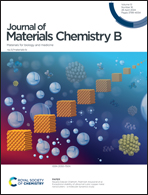Lipoic acid-mediated oral drug delivery system utilizing changes on cell surface thiol expression for the treatment of diabetes and inflammatory diseases†
Abstract
Lipoic acid (LA), which has good safety and oral absorption, is obtained from various plant-based food sources and needs to be supplemented through human diet. Moreover, substances with a disulfide structure can enter cells through dynamic covalent disulfide exchange with thiol groups on the cell membrane surface. Based on these factors, we constructed LA-modified nanoparticles (LA NPs). Our results showed that LA NPs can be internalized into intestinal epithelial cells through surface thiols, followed by intracellular transcytosis via the endoplasmic reticulum-Golgi pathway. Further mechanistic studies indicated that disulfide bonds within the structure of LA play a critical role in this transport process. In a type I diabetes rat model, the oral administration of insulin-loaded LA NPs exhibited a more potent hypoglycemic effect, with a pharmacokinetic bioavailability of 5.42 ± 0.53%, representing a 1.6 fold enhancement compared to unmodified PEG NPs. Furthermore, a significant upregulation of surface thiols in inflammatory macrophages was reported. Thus, we turned our direction to investigate the uptake behavior of inflammatory macrophages with increased surface thiols towards LA NPs. Inflammatory macrophages showed a 2.6 fold increased uptake of LA NPs compared to non-inflammatory macrophages. Surprisingly, we also discovered that the antioxidant resveratrol facilitates the uptake of LA NPs in a concentration-dependent manner. This is mainly attributed to an increase in glutathione, which is involved in thiol uptake. Consequently, we employed LA NPs loaded with resveratrol for the treatment of colitis and observed a significant alleviation of colitis symptoms. These results suggest that leveraging the variations of thiol expression levels on cell surfaces under both healthy and diseased states through an oral drug delivery system mediated by the small-molecule nutrient LA can be employed for the treatment of diabetes and certain inflammatory diseases.



 Please wait while we load your content...
Please wait while we load your content...